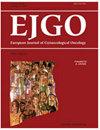A survey of lymph node involvement under preoperative medical imaging in cervical cancer patients
IF 0.5
4区 医学
Q4 OBSTETRICS & GYNECOLOGY
引用次数: 0
Abstract
Objective: To investigate the characteristics and distribution patterns of clinically metastatic nodes assessed by Computed Tomography (CT) in preoperative cervical cancer patients; to address the importance of obturator and/or inguinal lymph nodes as sentinel lymph nodes. Methods: A total of 217 patients with cervical carcinoma treated by lymph node dissection (LND) between 2009 and 2014 were included. All preoperative CT/MRI (Magnetic Resonance Imaging) imaging data of these patients were reviewed. The relationship of patient characteristics age, tumor stages, and corresponding lymph node metastasis status were analyzed. We put emphasis on the distribution pattern of positive lymph nodes from pre-operative imaging and compared the different frequencies of each regional and non-regional lymph node group respectively. The data of the 5-year survival rate from follow-up was taken into consideration too. SPSS 24.0 (IBM Corp., Chicago, IL, USA) was used for statistical analysis. Results: The overall lymph node metastasis (LNM) rate was 92.6% in 217 cases. When regional nodes were involved, obturator groups were concerned in 154 (76.6%). The inguinal group was involved in 146 (72.6%) in the area of non-regional lymph node. The 5-year survival rates of return visits were 92.6% and 82.1% in stage IB and IIA, respectively. Age distribution was not associated with the International Federation of Gynecology and Obstetrics (FIGO) stage as well as the incidence and patterns of nodal metastasis. Conclusions: obturator and inguinal groups play a decisive role in the metastases process of cervical cancer, and can be regarded as a candidate for sentinel lymph nodes.宫颈癌患者术前影像学下淋巴结受累情况的调查
目的:探讨宫颈癌患者术前CT临床转移淋巴结的特征及分布规律;探讨闭孔淋巴结和/或腹股沟淋巴结作为前哨淋巴结的重要性。方法:选取2009 ~ 2014年行淋巴结清扫术(LND)治疗的宫颈癌患者217例。回顾所有患者术前CT/MRI(磁共振成像)成像资料。分析患者特征、年龄、肿瘤分期及相应淋巴结转移情况的关系。我们重点分析术前影像阳性淋巴结的分布规律,并分别比较各区域和非区域淋巴结组的不同频率。随访的5年生存率也被考虑在内。采用SPSS 24.0 (IBM Corp., Chicago, IL, USA)进行统计分析。结果:217例患者总淋巴结转移率为92.6%。当局部淋巴结受累时,154例(76.6%)涉及闭孔组。腹股沟组有146例(72.6%)受累于非区域淋巴结。IB期和IIA期复诊5年生存率分别为92.6%和82.1%。年龄分布与国际妇产科联合会(FIGO)分期以及淋巴结转移的发生率和模式无关。结论:闭孔组和腹股沟组在宫颈癌转移过程中起决定性作用,可作为前哨淋巴结的候选者。
本文章由计算机程序翻译,如有差异,请以英文原文为准。
求助全文
约1分钟内获得全文
求助全文
来源期刊
自引率
25.00%
发文量
58
审稿时长
1 months
期刊介绍:
EJGO is dedicated to publishing editorial articles in the Distinguished Expert Series and original research papers, case reports, letters to the Editor, book reviews, and newsletters. The Journal was founded in 1980 the second gynaecologic oncology hyperspecialization Journal in the world. Its aim is the diffusion of scientific, clinical and practical progress, and knowledge in female neoplastic diseases in an interdisciplinary approach among gynaecologists, oncologists, radiotherapists, surgeons, chemotherapists, pathologists, epidemiologists, and so on.

 求助内容:
求助内容: 应助结果提醒方式:
应助结果提醒方式:


